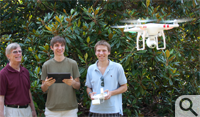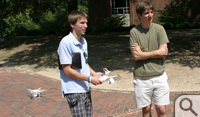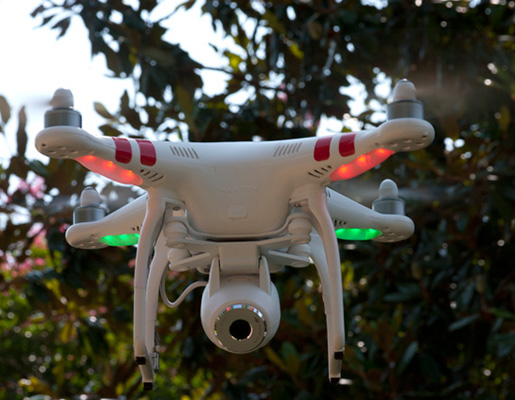It’s a Creative Adaptation
A quadcopter provides an overhead platform for recording classical mechanics
They don’t call it a drone, because it’s not a drone.
It’s a remote-controlled quadcopter, equipped with a wi-fi-linked video camera. It’s being used by William & Mary’s Department of Physics to create instructional modules for a new online initiative. There are distinctive differences between a quadcopter and a drone. To physicists, the distinctions are almost as important as the differences between weight and mass and momentum and kinetic energy—principles that the quadcopter is being used to illustrate.
A rule of thumb is that a drone is a long-distance vehicle. Reed Beverstock explained that a drone does virtually all of its flying out of the pilot’s range of vision, beyond the curve of the earth. A quadcopter, on the other hand, has a much shorter range—about 300 meters. Plus there’s another reason for the choice of terms.
“‘Quadcopter’ sounds so much cooler than ‘drone,’” he said.
A cool approach to Creative Adaptation
Beverstock ’14 and Daniel Duane ’15 make up a team that are preparing video modules to be used in an initiative titled Enhancing Problem-Solving Skills Using Online Tutorials. The project is one of four proposals that received support this year through Provost Michael R. Halleran’s Creative Adaptation Fund.
 Physicists David Armstrong, Bill Cooke and Wouter Deconinck are the investigators on the online tutorial project. They got the idea to use the quadcopter to make videos demonstrating examples of classical mechanics for students taking Physics 107 and 108, classes that usually attract a high number of pre-med students.
Physicists David Armstrong, Bill Cooke and Wouter Deconinck are the investigators on the online tutorial project. They got the idea to use the quadcopter to make videos demonstrating examples of classical mechanics for students taking Physics 107 and 108, classes that usually attract a high number of pre-med students.
“Everybody that gets into William & Mary and finds themselves in a pre-med physics class knows a lot of physics; they just don’t always understand the mathematics behind it,” Cooke said. Some students come to the introductory classes with ideas that need correction.
“Let’s say you’re spinning a ball on a rope, spinning it in a circle around your head, and the ball breaks free” Cooke said. “A very common misconception is that the ball continues to curve for a while. This is the kind of misconception that people have—that objects have a memory of what was being done to them. Of course, physics says that they have a memory of their velocity and that’s all.”
Adding the explanation in the editing booth
To illustrate and demonstrate the classical mechanics of the situation, Beverstock and Duane will set up a shoot in Barksdale Field or another site on campus. They’ll pilot the quadcopter above an assistant whirling a ball horizontally on a string. Then they’ll take the raw footage back for editing, adding in slo-mo, arrows, closed-caption explanations and other effects to make it clear that the freed ball sails off in a straight line, just as Mr. Newton said it should.
Beverstock and Duane are using conventional video cameras to create the modules as well. They’re both physics majors; Beverstock is taking a couple of years off before entering graduate school. Duane has done film since he was young and contributed a piece to the university’s student orientation program. He was a member of the team whose video won William & Mary’s 24-hour film festival.
 The quadcopter is a two-person operation. The dual-joystick controls require two hands, so a second person needs to hold the tablet that’s receiving the video feed. Duane more often does the navigating. “Reed is a better pilot,” he acknowledges.
The quadcopter is a two-person operation. The dual-joystick controls require two hands, so a second person needs to hold the tablet that’s receiving the video feed. Duane more often does the navigating. “Reed is a better pilot,” he acknowledges.
A two-person navigator-pilot team becomes an imperative on longer flights, especially when they’re getting fancy, flying the quadcopter through trees and around buildings. Beverstock and Duane sent the quadcopter on a shakedown flight over the Wren Yard, taking the camera soaring above the Wren Building, then back down, splitting the uprights of the Sunken Garden gates before going back up again.
“There’s a lot of tree cover around the Wren and there are times at which we couldn’t see the quadcopter, so I had Daniel looking at the tablet,” Beverstock said. “It was kind of a sanity check, to make sure that I’m not flying into the weathervane.”
Video-game experience is a bonus
The learning curve for piloting the quadcopter, which Cooke describes as “non-trivial,” varies from person to person. “I still haven’t had the chance to bug my mom about this,” Reed says, “but apparently experience playing video games helps.”
Anyone who has logged serious Xbox 360 time will be familiar with the dual-joystick quadcopter controller. In the air, the multiple blades of the quadcopter make it sound like the world’s biggest mosquito has stolen a weed whacker. Flying one requires a pair of deft hands on the controls, especially if there is more than a bit of a breeze.
“I have flown it occasionally and I started with an in-house accident in which I slashed my arm, television cables, all sorts of things,” Cooke said. “I got better after a little practice. It’s really easy to fly it into something.”
As they collaborate on their Creative Adaptation tutorial project, Armstrong, Deconinck and Cooke have divided up topics for development into instructional modules. The quadcopter team meets with each of the physics professors to discuss the principle to be developed and the best way to use video. The esthetic owes a lot more to YouTube than to the instructional video tradition.
“These videos need to be watched if the message is going to get across, so they can’t be sterile and boring,” Beverstock said.
The team aims to make classical mechanics interesting through filming scenarios such using a golf cart race to depict relative motion and using a tug of war between participants on floating air mattresses to illustrate Newton’s Third Law. The quadcopter will contribute to the “cool factor” of the finished videos, but Duane, the team member with the most video experience, points out that the flying camera also has pragmatic advantages.
“In addition to the cool factor, the quadcopter is very helpful because a lot of physics problems require a top-down, bird’s-eye view. That will really let you show all the pieces moving around when you want to show something like relative velocity,“ he explained. “If you were on the ground, you might not see everything going on at once.”
Goal: Three modules in the can by fall
The goal for the summer is to get a lot of raw video in the can and to have three complete modules ready to try out on the fall class of PHYS 107-108 students. Cooke explained that the tutorial modules will consist of three segments. An introduction will outline the concept, which will be followed by a section of more detailed work and examples. The third segment is sample problems. Each module is designed to facilitate easy review, he added.
“Although it’s one video, you can click on a subsection that will jump to any particular part of the video,” he explained. “So you can jump to that one small section, just like paging through a textbook.”
William & Mary’s Board of Visitors established the Creative Adaptation fund in 2011 to serve as seed capital for innovative projects likely to reduce costs, increase efficiency or increase revenues in the university’s academic areas.
















